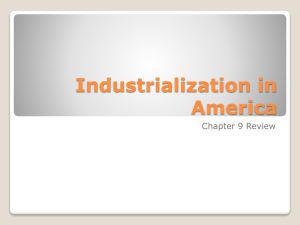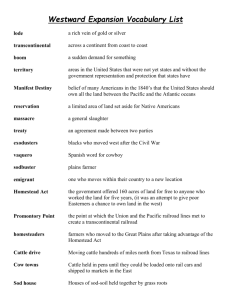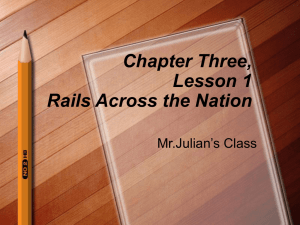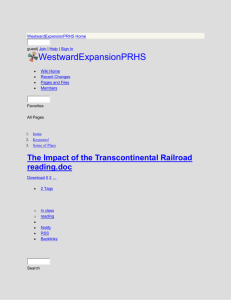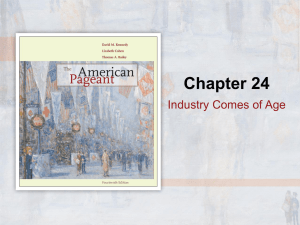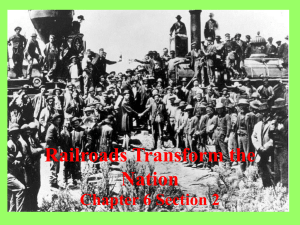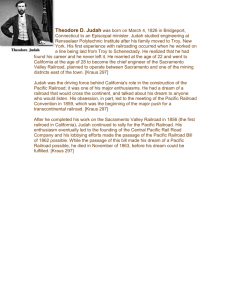Packet 3--Building the Transcontinental
advertisement
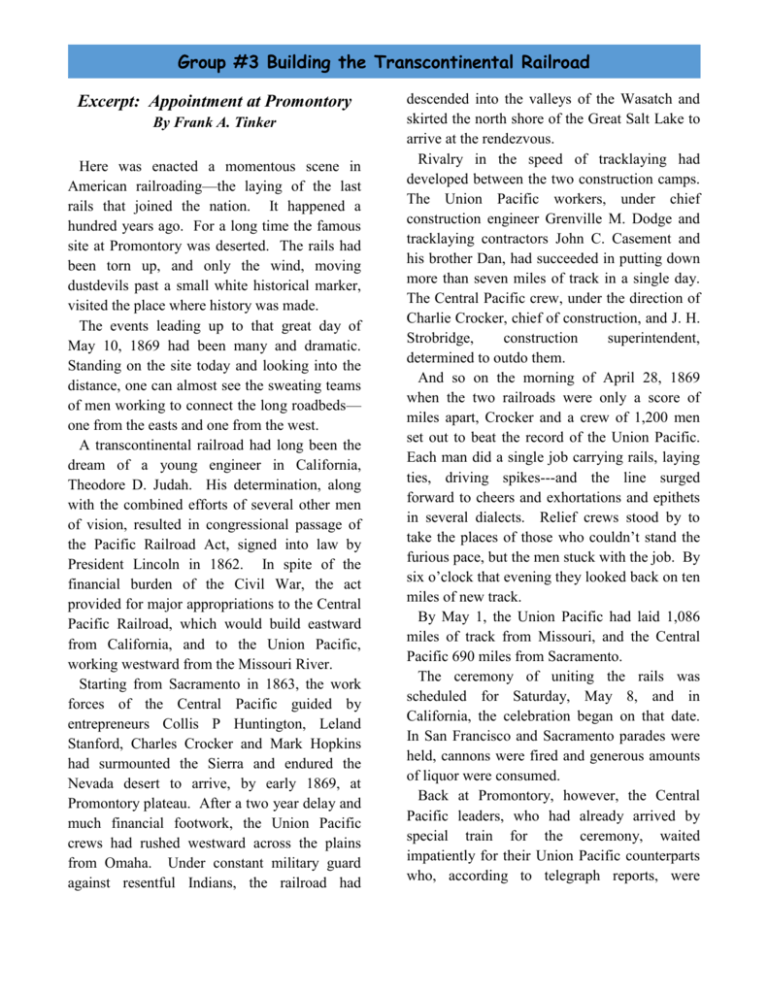
Group #3 Building the Transcontinental Railroad Excerpt: Appointment at Promontory By Frank A. Tinker Here was enacted a momentous scene in American railroading—the laying of the last rails that joined the nation. It happened a hundred years ago. For a long time the famous site at Promontory was deserted. The rails had been torn up, and only the wind, moving dustdevils past a small white historical marker, visited the place where history was made. The events leading up to that great day of May 10, 1869 had been many and dramatic. Standing on the site today and looking into the distance, one can almost see the sweating teams of men working to connect the long roadbeds— one from the easts and one from the west. A transcontinental railroad had long been the dream of a young engineer in California, Theodore D. Judah. His determination, along with the combined efforts of several other men of vision, resulted in congressional passage of the Pacific Railroad Act, signed into law by President Lincoln in 1862. In spite of the financial burden of the Civil War, the act provided for major appropriations to the Central Pacific Railroad, which would build eastward from California, and to the Union Pacific, working westward from the Missouri River. Starting from Sacramento in 1863, the work forces of the Central Pacific guided by entrepreneurs Collis P Huntington, Leland Stanford, Charles Crocker and Mark Hopkins had surmounted the Sierra and endured the Nevada desert to arrive, by early 1869, at Promontory plateau. After a two year delay and much financial footwork, the Union Pacific crews had rushed westward across the plains from Omaha. Under constant military guard against resentful Indians, the railroad had descended into the valleys of the Wasatch and skirted the north shore of the Great Salt Lake to arrive at the rendezvous. Rivalry in the speed of tracklaying had developed between the two construction camps. The Union Pacific workers, under chief construction engineer Grenville M. Dodge and tracklaying contractors John C. Casement and his brother Dan, had succeeded in putting down more than seven miles of track in a single day. The Central Pacific crew, under the direction of Charlie Crocker, chief of construction, and J. H. Strobridge, construction superintendent, determined to outdo them. And so on the morning of April 28, 1869 when the two railroads were only a score of miles apart, Crocker and a crew of 1,200 men set out to beat the record of the Union Pacific. Each man did a single job carrying rails, laying ties, driving spikes---and the line surged forward to cheers and exhortations and epithets in several dialects. Relief crews stood by to take the places of those who couldn’t stand the furious pace, but the men stuck with the job. By six o’clock that evening they looked back on ten miles of new track. By May 1, the Union Pacific had laid 1,086 miles of track from Missouri, and the Central Pacific 690 miles from Sacramento. The ceremony of uniting the rails was scheduled for Saturday, May 8, and in California, the celebration began on that date. In San Francisco and Sacramento parades were held, cannons were fired and generous amounts of liquor were consumed. Back at Promontory, however, the Central Pacific leaders, who had already arrived by special train for the ceremony, waited impatiently for their Union Pacific counterparts who, according to telegraph reports, were Group #3 Building the Transcontinental Railroad delayed by heavy rains. (Actually, irate laborers at Piedmont, Wyoming, had stopped the Union Pacific train and were holding it as ransom for their unpaid wages.) The money was finally produced and the trip was resumed. And at 11 o’clock on the 10th of May, 1869, the Union Pacific train chugged into view at Promontory. ... Spikes? Indeed. There was not one golden spike but two, donated by well-wishers in California. There was also a silver spike from Nevada and one of gold, silver and iron alloy from Arizona Territory. When the show actually got under way, shortly after noon, the spikes were presented with appropriate pomp by representatives of the donors and accepted likewise by the railroad representatives. Meanwhile, telegraphers who had set up their tables only a few yards apart were sending reassuring messages to the waiting world wondering at the delay. The final moment when east and west would meet had arrived. A polished laurel tie, presented by West Evans, tie contractor for the Central Pacific, was brought from the Stanford car and put in place. (Before the ceremony began the final gap between the two rails had been closed by the workmen, with only the south rail open and a place left for the laurel tie.) The necessary holes had already been bored in the tie so that the spikes would require only a tap to insert them. Thomas C. Durant, vice president of the Union Pacific, and Leland Stanford, president of the Central Pacific, stood at opposite ends of the tie with their mallets ready. Stanford’s silver mallet was looped with wire so that by touching the spike a connection was made to activate the telegraph. A few taps, the spikes fell into place, the resulting dits went over the waiting wires and then the final word: DONE. The two engines puffed toward each other, their cowcatchers touched and the crowd cheered. Several units of the 21st Infantry and the regimental band paraded. A bottle of champagne was broken over the engines and the rails. With the signal from the telegraph, celebrations began in every major city in the country…. By four o’clock the festivities were ended. The Central Pacific’s Jupiter pulled out to the west, the Union Pacific’s No. 119 to the east. Like most of the temporary construction camps along the line, the town of Promontory was dismantled and abandoned by the end of the year. Frank A. Tinker. “Appointment at Promontory,” Westways Magazine. Automobile Club of Southern California, Los Angeles, CA. Vol. 61, (May, 1969), pp. 2-4; 55. Group #3 Building the Transcontinental Railroad An Eyewitness Account – Alexander Toponce “I saw the Golden Spike driven at Promontory, Utah, on May 10, 1869. I had a beef contract to furnish meat to the construction camps of Benson and West. . . On the last day, only about 100 feet were laid, and everybody tried to have a hand in the work. I took a shovel from an Irishman, and threw a shovel full of dirt on the ties just to tell about it afterward. ... California furnished the Golden Spike. Governor Tuttle of Nevada furnished one of silver. General Stanford (Governor Safford?) presented one of gold, silver, and iron from Arizona. The last tie was of California laurel. ... When they came to drive the last spike, Governor Stanford, president of the Central Pacific, took the sledge, and the first time he struck he missed the spike and hit the rail. What a howl went up! Irish, Chinese, Mexicans, and everybody yelled with delight. ‘He missed it. Yee’ The engineers blew the whistles and rang their bells. Then Stanford tried it again and tapped the spike and the telegraph operators had fixed their instruments so that the tap was reported in all the offices east and west, and set bells to tapping in hundreds of towns and cities… Then Vice President T.C. Durant of the Union Pacific took up the sledge and he missed the spike the first time. Then everybody slapped everybody else again and yelled, ‘He missed it too, yow!’ It was a great occasion, everyone carried off souvenirs and there are enough splinters of the last tie in museums to make a good bonfire. Topence, Alexander, Alexander Topence, Pioneer (1923). 69” EyeWitness to History, www.eyewitnesstohistory.com Group #3 Building the Transcontinental Railroad New Map of the Union Pacific Railway, the Short, Quick and Safe Line to All Points West, Rand McNally and Company, 1883. Accessed from the Library of Congress. Digital ID: g3701p rr005950 htt http://memory.loc.gov/cgibin/query/r?ammem/gmd:@field%28NUMBER+@band%28g3701p+rr005950%29%29 Group #3 Building the Transcontinental Railroad Locomotive - Pennsylvania from the Transcontinental Railroad. http://www.tcrr.com/ Group #3 Building the Transcontinental Railroad Completing the Transcontinental Railroad. Promontory, Utah, May 10, 1869 Eyewitness to History (2004) http://www.eyewitnesstohistory.com/goldenspike.htm As the Promontory Point completion drew near, San Francisco contractor David Hewes had a solid gold spike created to commemorate the event. Its head was engraved with the words "The Last Spike", and its sides with the names of some of the prominent movers of the day. “Conversational Interface: The Golden Spike in Tomorrow's Internet,” Promontory Point Revisited: The Transcontinental Railroad and the Coming Conversational Interface, Acceleration Watch. http://www.accelerationwatch.com/promontorypoint.html Transcontinental Railroad Poster. “First Industrial Revolution 1840-1890 (Phase 2).” Lessons from History website. http://www.lessons-fromhistory.com/Images/Great%20Projects/transcontinental%20railroad%20poster.jpg Group #3 Building the Transcontinental Railroad Completion of the Pacific Railroad, May 10, 1869 -- The great link connecting Europe with Asia across the American continent.--[See page 341.]: From Views of Chinese published in The Graphic and Harper's Weekly. The Bancroft Library, University of California, Berkeley. Accessed through the Library of Congress. http://sunsite.berkeley.edu/cgi-bin/flipomatic/cic/images@ViewImage?img=brk00003079_16a Group #3 Building the Transcontinental Railroad A Timeline of Events (1850 – 1889) 1825 Peter Cooper finishes America’s first steam locomotive. The Tom Thumb carries passengers and goods along 13 miles of track between Baltimore and Ellicott’s Mills, Maryland. (PBS) 1841 The first settlers move westward across the Northern Great Plains on what will come to be known as the Oregon Trail. (PBS) 1845 Asa Whitney presents a resolution in Congress endorsing the funding of a railroad to the Pacific. His proposal dies due to the sectionalism in the country at the time. However, the idea of a transcontinental railroad lingers in the public consciousness. (PBS) 1848 The Gold Rush begins with the discovery of gold at Sutter’s Mill, drawing many fortune seekers including the Chinese to California. (CAM) September 9, 1950 California becomes the 30th state admitted into the Union. 1860 Theodore Judah solves the great riddle of the Pacific Railroad when he reaches Donner Pass and recognizes it as the ideal location for constructing a line through the Sierra Nevada. (PBS) 1861-1865 American Civil War 1862 The 13th Amendment abolishes slavery. 1862 Pacific Railroad Act is signed into law by President Lincoln.** This act provided for federal funding (money) to build the Central Pacific and Union Pacific railroads which were to eventually meet and join the eastern and western United States. With over 2,000 miles of tracks and built mostly by hand, the transcontinental railroad will establish a direct link from Nebraska to California. Group #3 Building the Transcontinental Railroad Timeline of Events (#3 - Transcontinental Railroad) – continued (2) 1865 Union Pacific: President Abraham Lincoln asks Massachusetts senator Oakes Ames to help manage the building of the railroad. Central Pacific: Contractor Charles Crocker convinces foreman James Harvey Strobridge to try Chinese workers as a means of expanding their labor force, which at this time numbers just a few hundred Irishmen. He is joined by a group of men who become known as the “Big Four” (Leland Stanford, Charles Crocker, Mark Hopkins, and Collis P. Huntington) (PBS) 1865-1866 Union Pacific: At the end of the Civil War, thousands of soldiers joined Irish immigrants to work on building the Union Pacific railroad. (PBS) 1865-1869 Central Pacific: The railroad company recruits thousands of Chinese laborers. (CAM) Faced with white workers demanding higher wages and threatening strikes, the Central Pacific Railroad Company of California reluctantly hired fifty Chinese laborers, who were considered too frail for the job. As the Chinese proved to be reliable workers, the company began to recruit more Chinese workers. While white workers were paid $35 a month with free board (a place to live), the Chinese were paid $26 to $35 without free board. When completed, 15,000 to 17,000 Chinese had worked on the railroad. December 21, 1866 Union Pacific: Upset by increased military presence in the Powder River Valley, the most sacred and fertile hunting ground remaining in their possession, a group of Sioux warriors draw Captain William J. Fetterman and his troops into a deadly ambush on the Boseman trail. (PBS) June 25, 1867 Central Pacific: Work in the Sierras grinds to a halt as Chinese workers strike (refuse to work) for better wages and shorter hours. The railroad company cuts off food, supplies, and communication to the Chinese camps. One week later, the men will go back to work at the same wage. (PBS) Group #3 Building the Transcontinental Railroad Timeline of Events (#3 - Transcontinental Railroad) – continued (3) July 4, 1867 Union Pacific: The town of Cheyenne in Wyoming Territory is founded. Intended as a transfer point on the Union Pacific line, it will contain the company roundhouse and a military station. By year’s end, the settlement’s population will exceed 4,000. August 27, 1867 Union Pacific: A group of Cheyenne warriors bends rails and pulls up track at Plum Creek, Nebraska. The resulting destruction derails a work train, which the warriors loot and burn after killing its crew. The only survivor escapes with a scalp in hand. (PBS) April 16, 1868 Union Pacific: Railroad construction reaches the highest point on both lines: Sherman Summit, at an elevation of 8,200 feet in the Rockies. The race for completion – and territorial holdings – is on. (PBS) August, 1868 Central Pacific: Mormon leader Brigham Young provides Mormon laborers to help with the work through the Utah desert. (PBS) October 29, 1868 Union Pacific: A number of “Hell on Wheels” towns have sprung up, following the building of the railroad. In Laramie, Wyoming, the citizens form a Vigilance Committee because they get tired of the lawlessness. Following a feverish gun battle, the townspeople succeed in forcing gamblers and outlaws from their settlement, hanging those who remain from telegraph poles and log cabin rafters. (PBS) November 6, 1868 After months of skirmishes Native American leader Red Cloud signs the Powder River Treaty, which guarantees the Sioux their massive hunting grounds “in perpetuity (forever). Red Cloud is thus considered the only native leader to have won a war with the United States. (PBS) Group #3 Building the Transcontinental Railroad Timeline of Events (#3 - Transcontinental Railroad) – continued (4) April 28, 1869 Central Pacific Victory Day: Charles Crocker decides he has one last thing to show the Union Pacific and the world. In a remarkable feat of strength and organization, his Central Pacific crews lay an unheard-of 10 miles of rail between sunrise and sunset. (PBS) May 10, 1869 ** Promontory Point, Utah: Amidst a crowd of dignitaries and workers, with the engines No. 119 and Jupiter practically touching noses, the Central Pacific and Union Pacific railroads join together. Telegraph operators transmitting to both coasts transmit the blows of the hammer as they fall on a golden spike. The nation listens as west and east come together as an undivided nation. (PBS) The Central Pacific Railroad (being built eastward from California) and the Union Pacific Railroad (working westward from the Missouri River) are finally joined together. The transcontinental railroad is complete. ** 1876 The Southern Pacific Railroad connects San Francisco and Los Angeles, California. 3,000 Chinese railroad workers finished laying the last 1,050 feet of track linking northern and southern California. After completion of the railroad, hundreds of Chinese railroad workers move to Los Angeles. (CAM) 1882 Ignoring the crucial role the Chinese immigrants played in constructing the Central Pacific, Congress passes the Chinese Exclusion Act, banning further immigration of Chinese laborers into the United States for a period of 10 years. (PBS) 1884 Bursting with the profits of the railroad and bereft over the death of their teenage son, Leland and Jane Stanford endow the Leland Stanford Junior University on family land in Palo Alto, California. (PBS) 1889 An agreement with the U.S. government divides up Sioux territory in the Powder River Valley. The Sioux disperse to six smaller, disconnected reservations, and the last great holding of the Native American people is thrown open to white settlement. (PBS) Excerpts and content from “A Timeline of Events,” Our American Journey, Educator’s Guide Chinese American Museum, Los Angeles, CA (2010), pp. 68, 14-15. (CAM) Mark Zwonitzer, Producer. “Transcontinental Railroad,” American Experience – 25 Years. A Hidden Hill Productions Film. (2003); Online: Public Broadcasting Station, http://www.pbs.org/wgbh/americanexperience/features/timeline (PBS) *Asterisks denote content included in articles from Westways Magazine, Automobile Club of Southern California.


